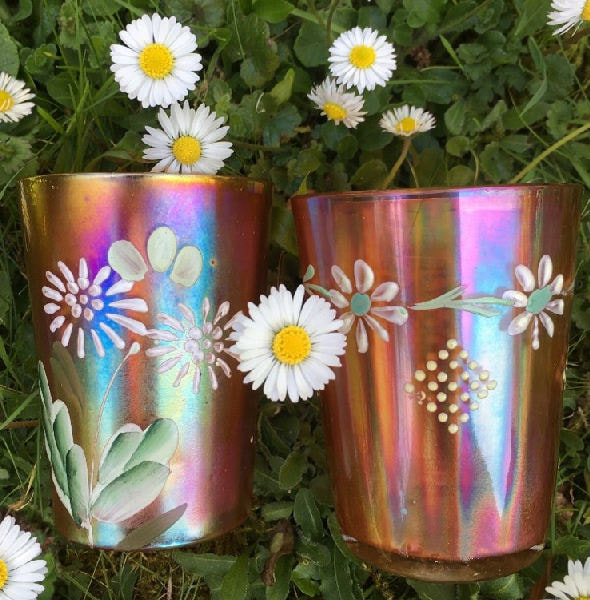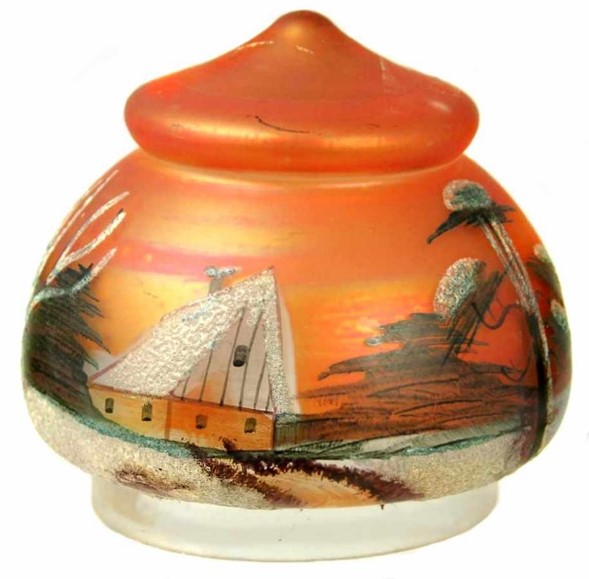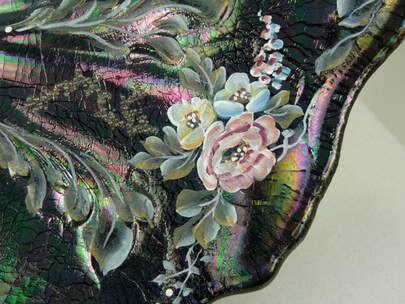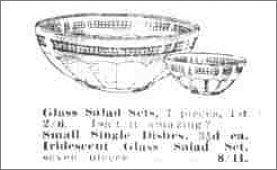NetworK ezine Issue 68. January 2021
Totally Devoted to Carnival Glass
There’s no better way to start 2021 than with a heartfelt wish
to all our readers for good health and good luck!
to all our readers for good health and good luck!
|
And there’s no better way to illustrate our wishes than with a close-up detail of Harry Northwood’s iconic and beautiful Good Luck pattern (right). Note how the horseshoe is hung points down, which appears to go against what some believe to be the “right way” to hang a horseshoe. But, it’s exactly the right way to spread the good luck everywhere and to everyone. There are two schools of thought on whether the horseshoe should be hung up or down ... and it seems either way has its benefits. Points up catches and keeps the good luck. Points down allows the good luck to flow out over everyone. So that's auspicious ... let the good luck spread all over to everyone. And let’s spread good will and good fortune with Carnival Glass. |
How Did They Do It?
Many Carnival collectors have a general understanding of the main processes involved in the production of Carnival Glass – but few explained it better and in full detail, than the late Howard Seufer. Here we show a brilliant educational resource, created by Howard, that shows step-by-step how a Carnival pressed bowl would be made, and the titles of all the workers involved in that process. Howard’s graphic is shown below in small size, and we have also placed it on our website in a larger format (for ease of viewing), and with additional illustrations and information.
Many Carnival collectors have a general understanding of the main processes involved in the production of Carnival Glass – but few explained it better and in full detail, than the late Howard Seufer. Here we show a brilliant educational resource, created by Howard, that shows step-by-step how a Carnival pressed bowl would be made, and the titles of all the workers involved in that process. Howard’s graphic is shown below in small size, and we have also placed it on our website in a larger format (for ease of viewing), and with additional illustrations and information.
|
Copyright and courtesy the late Howard Seufer and Marty Seufer.
To view Howard's presentation in full, click on the graphic, or go here: Howard Seufer's Presentation. |
Above: glass being reheated at the glory hole.
Image by Lewis Hine, c 1910, source U.S. Library of Congress. |
|
Glass is taken to the lehr by the carry-in boy.
Image by Lewis Hine, c 1910, source U.S. Library of Congress. |
Almost a century after Hine's images, here is the iridising spray (dope) being applied to the glass held in a snap tool, taken at Fenton in February, 2000. Courtesy (the late) Howard Seufer.
|
We have more more about the workers employed in the glass factories around the time that Carnival was first being made, here: Glassworkers
Gilding the Lily
|
Carnival Glass, with its glorious iridescence, is delightfully decorative in itself, but sometimes the glass makers chose to add various extras in terms of decoration. On the right is a blue Northwood Apple Blossom enamelled water pitcher, and below is a 1910 Butler Brothers ad for Dugan’s decorated peach opal bowls. The floral patterns were hand-painted in enamel. The designs are (left to right): Lily of the Valley on a Stippled Flower bowl, Forget-Me-Nots on a Stippled Petals bowl, and Roses on a Cherries bowl.
|
A blue Northwood Apple Blossom enamelled water pitcher
|
One of the very popular methods of decoration in the Classic Carnival era was hand painting on the iridised glass. The artists (usually women) would have worked in the Decorating Room, using enamel paints – pigmented paints that have finely ground glass in them. This would then have been fired-on – as it is re-heated the mixture melts and fuses to the surface of the glass. You’ll see in the ad above that it describes the decoration as “burnt in, will not wash off”.
The decorated marigold tumblers shown below are both Fenton. Double Daisy is on the immediate right, and Dotted Diamonds & Daisy is on the far right.
|
The names of some of the early Fenton decorators who could have painted these tumblers are known, courtesy Fenton Art Glass: “Carrie Howell, Lizzie Moore, Bertie Rhumbach, and Carrie Wood. Charles Fenton was in charge of the decorating shop and it’s believed that Frank Fenton and John Fenton probably designed the decorations (and perhaps they all wielded brushes and did some actual decorating too).” Fenton, Dugan and Northwood all produced hand painted Carnival – the shapes made were predominantly water sets and bowls, but occasionally a table set item can be found. Dugan limited the shapes they enamelled to bowls, while Northwood and Fenton mainly concentrated on pitchers and tumblers. Flowers and fruits were the main motifs chosen on the USA made items, and the artists would have had templates to follow. |
Enamelled Carnival lampshades in several shapes were made in Czechoslovakia and they often depicted snowy scenes with castles, houses and churches in the landscape. This marigold shade, above right, has traces of a paper label that reads “Made in Czechoslovakia”. Glass frit (tiny particles of glass) have been added to the enamel paintwork to give a textural impression of snow and frost.
|
This Butler Brothers extract from 1916 shows two Fenton enamelled water sets. On the left is Chrysanthemum and on the right of the ad is a tankard pitcher, which is one of several versions of Forget-Me-Not. On the right is a blue example which uses the Prism Band blank.
|
The decorators worked from "templates" which showed the design to be replicated, but inevitably, there were big variations in how the design was interpreted, or executed by different decorators.
Above are two blue Northwood Ground Cherries tumblers. The usual version is on the left, and on the right is a "variant", where the decorator omitted elements of the design - the lower white scroll and the two orange fan shapes. We hope it was not a sackable offense! |
What is especially interesting – and frankly curious – about the Butler Brothers' ad, is that the tumbler with the Forget-Me-Not tankard is usually known as Crocus (and matches up with a different pitcher). Is this indicative of a relaxed mix-n-match approach, or was there a surplus of the Crocus style tumblers?
Whilst talking about decorated Carnival, we can’t resist showing this amazing 1915 Lee Manufacturing Catalogue illustration. The “Hand Painted Iridescent Glass” water set depicted in the wholesaler’s supplement was probably Northwood’s Cherries & Little Flowers. Fenton made a similar pattern but the details on this are more suggestive of the Northwood version.
We have always been fascinated by the decorated / enamelled pieces, and there is a lot of information about them, and picture Galleries elsewhere on our website. Here are some links if you want to explore further.
Enamelled Forget-Me-Not pitchers and a fascinating 1912 ad from Sears Roebuck: Forget-Me-Not
Fenton: Fenton Enamelled Tumbler Gallery
Northwood: Northwood Enamelled Tumbler Gallery
Enamelled Forget-Me-Not pitchers and a fascinating 1912 ad from Sears Roebuck: Forget-Me-Not
Fenton: Fenton Enamelled Tumbler Gallery
Northwood: Northwood Enamelled Tumbler Gallery
Other forms of decorating were carried out too. Staining and gilding were favourite techniques although they are not seen very often on Classic Carnival.
|
One most unusual decorative style was the imitation of a green verdigris patina, to produce an ancient, weathered effect. Rindskopf perfected this look on their Egyptian Queen and Classic Arts items, as shown in the photo above.
Take a look at these beautiful and elegant stemmed wines from Brazil. They are shown here thanks to Claudio Deveikis and the owner, Thiago Zanette. Although not strictly Carnival Glass (as they do not have a moulded pattern) these are superbly iridised and skilfully engraved.
The decorative engraving design is shown in Esberard’s catalogue which can also be seen below on the right, courtesy of Clóvis Bezerra. |
The Polish Carnival makers, Hortensja and Zabkowice, developed a very distinctive style of decoration based on selective iridescence. Parts of the glass were left clear (and often highly polished) allowing the iridised portions to show the design more clearly.
Above: Tulips oval platter, made by Hortensja Below: Zabkowice's Diana The Huntress bowl. In fact, Zabkowice made a wide range of designs in this style where the pattern is intaglio on the underside of the base, and selectively iridised in marigold. Many of them are in this major feature: Zabkowice's Golden Treasures.
|
|
Contemporary Decorating at Fenton
The reintroduction of decorating at Fenton in 1967 was a case of returning to its roots, as they had begun in 1905 as a glass decorating firm in Martins Ferry, Ohio, working on glass “blanks” from other firms. In 1907, when they moved to Williamstown in West Virginia, decorating was still a very important part of their operations. During the years of the Great Depression, the Fenton decorating department was closed down, but in 1967 it was decided to bring back decorating techniques again on the glassware. The following year, Louise Piper was employed as chief decorator in the newly created Decorating Department. Louise had always been fascinated with glass decorating and had learnt the skills and techniques whilst employed at the Jeanette Shade and Novelty Company. She reported that “they taught me to layout designs, to mix colors and other things such as what colors could be fired over the top of another color.” Louise soon developed some iconic designs (such as Violets in the Snow) and she trained up a group of decorators in the requisite techniques. Over the years, many such decorators followed (their work is usually signed) and names such as Martha Reynolds and Frances Burton will be familiar to Fenton collectors. Here is one of our personal favourites from another very talented Fenton decorator, Martha Reynolds. It is an Acanthus plate - although it is an old Imperial pattern, this piece was reintroduced by Fenton in the mid 1990s. The base glass is black and the iridescence is magnificent, with a beautiful “stretch effect” that shows greens and pinks. |
A superb miniature Moring Glory pitcher,
decorated and signed by Louise Piper (pictured top right). This beautiful plate belongs to our daughter, Angie. It was hand painted by Martha Reynolds and it has added coralene decoration (a mix of enamel paint with tiny glass balls that partially melt onto the surface when re-heated, producing an effect like coral). |
|
Five Rings
Peter Phillips wrote to us from Australia about a 1924 Woolworths ad we show on our website (NetworK Christmas Special #3). He said: "I was interested to see the advert showing the Plain (aka Five Rings) bowl sets. It's the first time I've seen anything about the small bowls ... the large bowls turn up regularly but I've only ever seen three of the small bowls, which are slightly smaller than the nappy bowls that we see with the other sets ... ie Kangaroo, Kookaburra etc. I've taken a picture of the bowl I have alongside a Kookaburra nappy as a size comparison." Above: the same Plain / Five Ribs bowl and a slightly larger Crown Crystal
Kookaburra nappy in dark for size comparison. |
Above: an extract from the Woolworths 1924 ad.
Below: a marigold Plain / Five Ring small bowl made by Crown Crystal Photos courtesy of Peter Phillips.
|
An amazing find from Poland
Reported in December by Justyna Świątek in our Carnival Glass NetworK Group on Facebook, was this stunning new find from Zabkowice, Poland.
|
It is a low, ice cream shaped bowl in rich marigold - it is Zabkowice's 1246 pattern, and it features a magnificent and detailed geometric design. Justyna's bowl is shown on the left, and above with an extract from the 1920 Zabkowice catalogue.
Pictures courtesy and copyright of Justyna Świątek. Catalogue extract courtesy and copyright of Dieter Neumann. |
Wishing everyone, all over the world, Happy Holidays and a safe, healthy New Year.
If you have missed any of the previous issues of NetworK and NetworK Specials, they are all here: Back Issues.
Privacy and the use of your information: we only use your name and email address to send you your FREE Carnival Glass NetworK ezine. We will not share your name or email address with anyone else, or use it for any other purpose. You can change your mind about receiving your NetworK ezine at any time by clicking the unsubscribe link at the foot of every issue, or by emailing us at [email protected]
Join us on Facebook
We would love you to come and join in the fun, and we invite you and your friends to join us all on NetworK's fast growing and very active Facebook Group!
We would love you to come and join in the fun, and we invite you and your friends to join us all on NetworK's fast growing and very active Facebook Group!




























